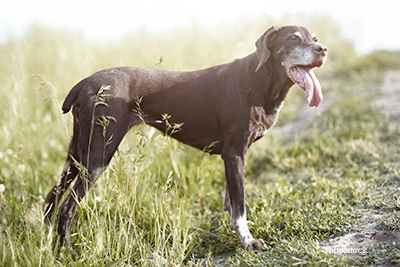
Liquid gold. That’s the nickname for urine I was taught in veterinary medical school. We learned urine could provide us with such valuable insight into a patient’s health, that it was worth its weight in gold. We also learned that the color and consistency of urine, from light yellow to black and clear to cloudy, signaled health or illness. If you’ve ever pondered what your dog’s pee color meant, here’s a description of your dog’s urine spectrum.
What is normal urine color for dogs?
The normal color of urine from a healthy dog or cat is transparent yellow. Veterinarians sometimes refer to this color as “straw yellow,” “pale gold,” “amber,” or “clear yellow.” The most accurate way to assess urine color is to examine it in a clear plastic or glass container against a white background. Urine is made as a normal result of metabolism and removal of cellular wastes. Normal urine is sterile and the color can vary depending on what your pet has recently eaten or drunk. If you’re wondering why urine is yellow, it’s due to the presence of a substance called urochrome which is excreted by the kidneys.
What do different shades of yellow mean?
The intensity of yellow color in normal, clear urine indicates the concentration or dilution of urine. In simplest terms, dilute urine is associated with increased water excretion and concentrated urine correlates with less water. Dilute urine will be almost colorless while highly concentrated urine is bright yellow, amber or honey colored. Minor daily variations in yellow shouldn’t alarm you. Persistent color changes lasting more than a couple of days should be brought to your veterinarian’s attention. Colorless or bright-yellow urine can also be associated with certain medical conditions. In general, yellowish urine is normal.
What if my dog’s urine is dark yellow?
It’s not unusual for a dog’s urine color to be dark yellow. However, if your dog has dark or bright yellow urine, especially after a long day outdoors, it could signal a need to consume more water.
What if my dog’s urine is dark enough to look orange?
Dark yellow is typically normal in most pets. If the urine is more orange, it may be associated with a condition known as icterus or jaundice. Orange urine may be the result of:
- Damaged red blood cells
- Liver disease
- Severe dehydration
- Bile duct problems
- Gallbladder problems
- Pancreatic problems
If your pet has orange colored pee, additional blood and urine tests need to be performed immediately.
What if my dog’s urine is red, pink, red/brown, or red/orange urine
Red or pink urine is often caused by a urinary tract infection. Many times you will also notice the urine is cloudy or turbid. Other reasons for reddish urine include feline lower urinary tract disorder, cystitis, bleeding or clotting diseases, trauma and cancer. Red urine clearly indicates your dog needs additional diagnostic tests to determine the cause of color change.
What if my dog’s urine is brown to black
Brown to black urine can signal something serious has happened. The dark color can be due to blood cell damage releasing hemoglobin, muscle damage from trauma, or toxins such as onions, garlic, zinc, or acetaminophen (Tylenol®).
If your dog’s urine changes color, seek veterinary help
If your dog’s urine changes hue, call your veterinarian. A simple urinalysis will determine if your dog requires additional tests, and appropriate treatment. You’re most likely to observe color changes associated with uncomfortable urinary tract infections (UTI’s) and painful cystitis. The sooner you treat, the less discomfort your loved one will suffer.
Next learn why your veterinarian might want a urine sample from your dog >>
If you have any questions or concerns, you should always visit or call your veterinarian -- they are your best resource to ensure the health and well-being of your pets.
References:
- Clinical Veterinary Advisor – Dogs and Cats Third Edition, Etienne Côté DVM, DACVIM Editor-in-chief. Elsevier 2015 pp. 1272, 1440-1441

Dog Kidney Disease Articles
Chronic Kidney Disease: What Does Kidney Failure in Dogs Really Mean?10 Common Causes of Kidney Disease in Dogs
